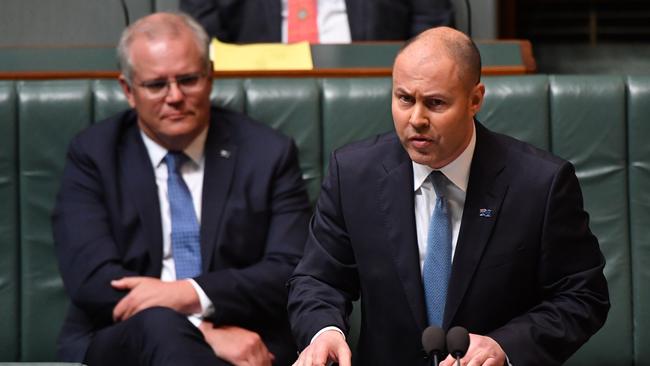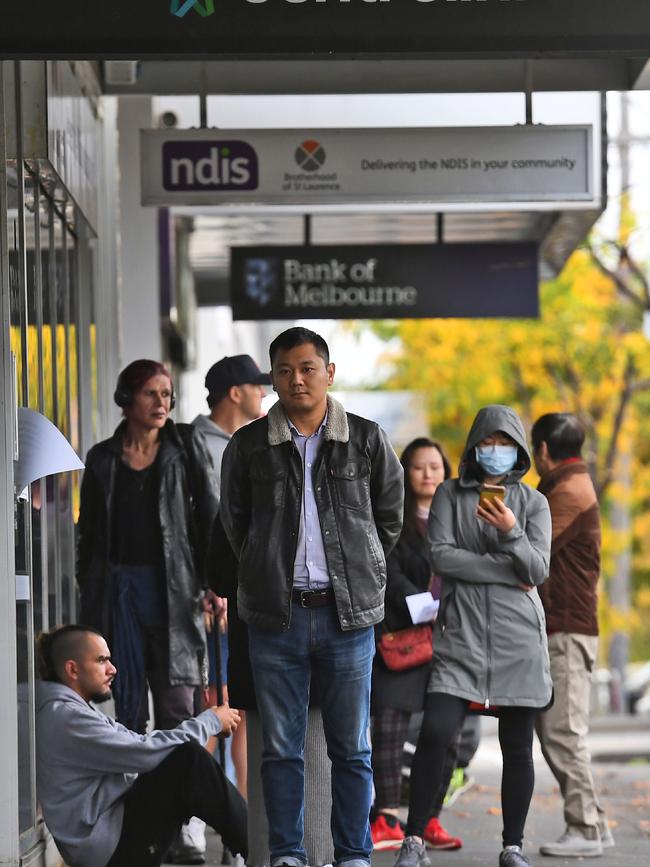Budget 2020: Frydenberg rolls dice against unseeable foes
The Treasurer’s bespoke recession-busting policies are hostage to two capricious sprites.

The showstopping twin measures in Tuesday’s budget were the $26.7bn tax break for business investment and the $4bn hiring credit for employers. Both policies take effect immediately, and won’t cost the budget an awful lot, given the times and maxi settings on the taxpayer money-pump. Canberra’s spending footprint is $670bn in the current financial year, equivalent to 35 per cent of gross domestic product.
Businesses with a turnover below $5bn will be able to deduct the full cost of depreciable assets in the year they are installed. It’s the Godzilla version of the government’s instant asset write-off schemes. There’s no cap on how much can be claimed. Frydenberg calls it a “game changer” for investment, which was a drag on the economy pre-pandemic.
But the targeting excludes the nation’s largest companies, perhaps the top 100, those most likely to invest early and often before the June 2022 deadline. It’s a political judgment as much as an economic one, cutting out the banks, miners, big retailers, medical tech giants and industrial companies. In a sense, these big Australians have had a “good pandemic” compared with small businesses. Since mid March, when the number of COVID-19 infections hit 100, the number of people employed by large companies (more than 200 workers) has fallen by 1.3 per cent; at the lowest ebb, in mid April, employment for these companies fell by just over 5 per cent.
By contrast, the number of payroll jobs for small companies (fewer than 20 employees) has fallen by 7.3 per cent in that time; at the worst moment, also mid April, small businesses, many in the hospitality and tourism sector, had shed 11.3 per cent of staff.
Of course, the investment allowance is second-best policy, compared with a cut to company tax. But given the crapshoot in the Senate, killing anything with a whiff of off-centre, Frydenberg and Morrison chose the pragmatic option.
Over the medium term, this measure is worth $3.2bn, not the $26.7bn it costs over the four-year forward estimates period. Bringing forward the write-off to the first year means there will be no depreciation to claim against income in subsequent years. As well there’s a $4.9bn temporary loss carry-back (where losses incurred up to 2021-22 can be carried back against profits made in or after 2018-19).

Treasury estimates these two measures will create 50,000 jobs and boost GDP by $12.5bn by June 2022. Frydenberg knows the X-factor is confidence, among consumers and employers, and that depends on how quickly a vaccine arrives and no new major virus outbreaks. Treasury assumes a vaccine will be available from the end of next year. A vaccine by July would boost the economy by $34bn over two years. More outbreaks, and the imposition of restrictions on 25 per cent of the economy for 18 months, would make it $55bn smaller.
“The speed and trajectory of the economic recovery is very dependent on successful suppression of the virus,” Frydenberg told Inquirer on the eve of the budget. “We need businesses big and small feeling confident about the economic environment so that they can innovate, invest, grow and hire more people.”
The JobMaker hiring credit excludes the big banks, perhaps due to the lingering taint of the royal commission and the long echo of the prime minister’s “Nobody likes you” taunt in 2017. Most likely, the move recognises the banks are well capitalised and have had access to an ocean of cheap money from the central bank.
The new scheme, aiming to “support around 450,000 positions”, is focused on the young unemployed, who have borne the brunt of the COVID recession to date. According to the Australian Bureau of Statistics, actual hours worked in August were 12 per cent below March for those aged 15-24 years and 6.9 per cent below for those aged 25-34 years. This compares with 2.8 per cent and 1 per cent respectively for persons aged 35-54 and the 55-plus group.
Employers will get a credit for each new job they create over the next 12 months. They will receive $200 a week for up to 12 months if they hire an eligible person (someone who has been on JobSeeker, Youth Allowance or Parenting Payment for at least one of the previous three months at the time of hiring). They’ll pocket $200 a week if they employ a job seeker aged 16 to 29, or $100 if they hire a worker aged 30 to 35.
On Thursday Anthony Albanese accused the government of leaving those aged 35 and over “on the scrap heap”. The ACTU sees a job churner rather than a job maker. Yet as University of Melbourne economics professor Jeff Borland notes, the new policy is trying to deal with a pressing issue and a potentially worse long-term problem.
“History tells us that if the recession lasts for the next couple of years, it will also be young people who are worst affected in that phase — because they account for an above-average share of jobseekers at a time when job creation is slower than usual.”
Borland says setting the subsidy rate is the most difficult part of a hiring credit policy, but $200 looks generous enough. It means a subsidy of around 50 per cent for an employee working 20 hours at the minimum wage, “which should give a decent extra incentive for hiring”.
Borland says the flat rate is a good feature. “It means that the greatest incentive to hire young workers exists for those who are low skill — who are the group who are generally found to be worst affected (from among the young) during recessions,” Boland says.
Will the hiring credit be taken up in sufficient numbers by employers and spent on creating jobs that would not otherwise have been created? Wage subsidy programs are complex to design and success depends on factors out of the government’s control, such as whether growth is strong enough for employers to take on extra workers.
Borland thinks design of the program has given it the best chance of working. First, there are conditions to ensure the credits are spent on jobs that are additional to existing employment. Second, businesses receiving JobKeeper cannot receive a hiring credit, so it isn’t possible for businesses getting JobKeeper to use the credit to rehire workers who they had laid off because of COVID-19 but are now able to rehire as normal business resumes. Third, the amount of subsidy should give a decent incentive for extra hiring by employers.
The legislation for the hiring credit has a lot of “fill in the blanks” aspects so the Treasurer can tweak the scheme; it’s likely there will be further iterations to address emerging areas of need. For now, the priority is the young, who are most susceptible to “scarring” in the labour market.
If the recovery falters, the hiring credit fails. “For employers to be considering hiring, they must expect or believe that there is a chance of an increase in demand for their output,” says Borland. “If they don’t see a chance of increasing business, then even with the subsidy, they won’t be willing to hire.”
As Treasury points out in the budget papers, uncertainty abounds with myriad forces that could derail the revival: second and third waves, financial crises, business failures and geopolitical instability. The Treasurer’s plan depends on the invisible and incredible. “You can provide all the incentives you want to a business to hire,” Frydenberg says. “But unless that business has the plan and the confidence to grow and invest, then that (unemployed) person will have nothing to do”.




The Morrison government’s $500bn four-year spending spree is a big bet on a heavy track. Josh Frydenberg wants to put the nation on a virtuous cycle of growth, jobs and budget repair. But the Treasurer’s bespoke recession-busting policies are hostage to two capricious sprites: COVID-19 and the animal spirits of capitalism.